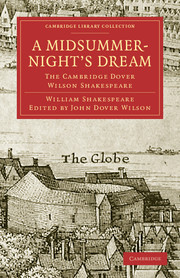THE COPY FOR THE TEXT OF 1600
Published online by Cambridge University Press: 07 September 2010
Summary
The Fisher Quarto (1600), the Jaggard Quarto (1619), and the Folio text
All scholars are now agreed that the editio princeps of the play in this volume is the quarto published in 1600 by Thomas Fisher. A moment's attention, however, is due to another quarto, printed according to its title-page ‘by lames Roberts, 1600,’ and obviously set up from a copy of Fisher's edition, which indeed it imitates typographically with striking, not to say suspicious, fidelity. The existence of this remarkable reprint, belonging on the face of it to the same year as its predecessor, though evidently from a different printing-house, had long been one of the standing puzzles of Shakespearian textual criticism, when in 1906–9, by what ranks as the most brilliant and convincing feat of modem bibliography, Professor A. W. Pollard and Dr W. W. Greg were able to prove that the book, so far from being ‘printed by lames Roberts, 1600,’ was actually printed, together with eight other Shakespearian or pseudo-Shakespearian texts, by William Jaggard in 1619. It was in fact a fake, and editors might altogether disregard it from henceforth, did it not claim a small niche in the temple of fame as the link between the Fisher Quarto and the Folio version. In other words, Jaggard's compositors in 1623 used one of Jaggard's 1619 books as ‘copy,’ and it follows that the Folio version of this play is in substance only the reprint of a reprint, which not merely transmits most of the printer's errors of 1619 but also adds on its own account the usual crop of fresh errors that we expect in a Folio text taken from a quarto.
- Type
- Chapter
- Information
- A Midsummer Night's DreamThe Cambridge Dover Wilson Shakespeare, pp. 77 - 100Publisher: Cambridge University PressPrint publication year: 2009First published in: 1924

